October 2018
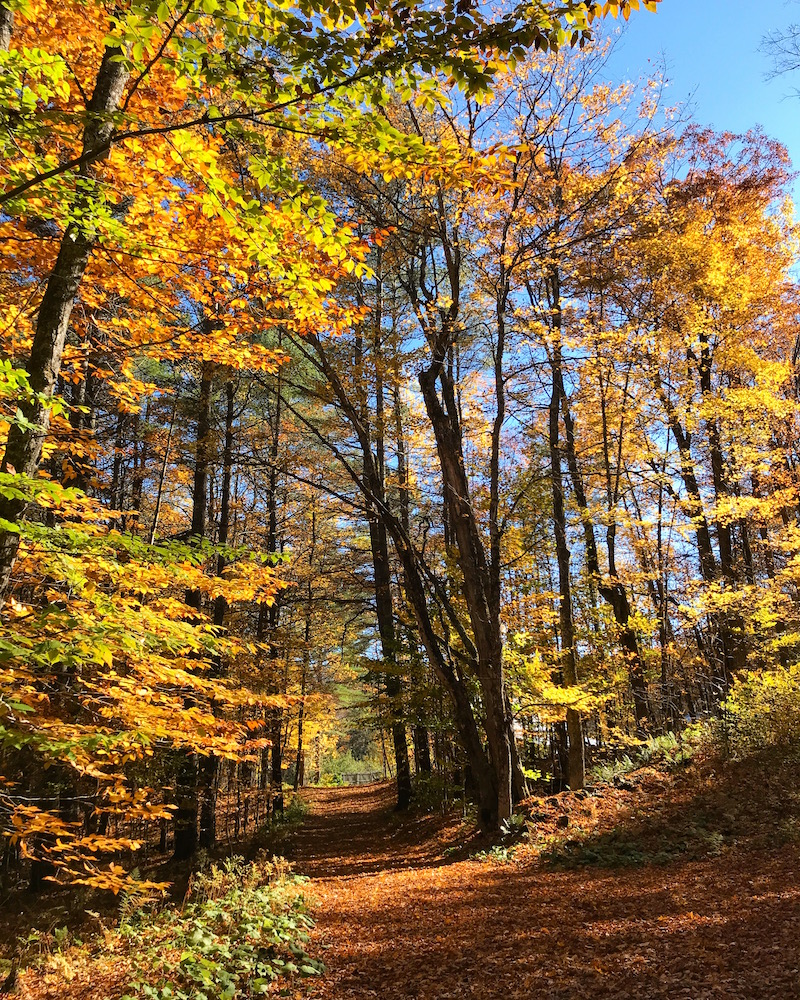
Transition visits in October. We’re caught balancing between two extremes, tentative and uncertain, unable to find sure footing in either fall or winter. There’s a riot of color on every leaf and the trees look fake with saturation. The oranges and reds and yellows all cluster around, pushing into our faces, swarming at our feet, demanding we notice their brilliance.
And then, it snowed. A demure snow, doing a trial run to see how the earth feels underneath each timid flake. Everything goes white for a few hours as the snow appraises its position and considers how it might lunge and drift as winter intensifies its strength. But it’s not time for that yet. By afternoon, most of the snow recedes, pushed out by a boisterous late fall sun, determined to demonstrate that this snow was precocious.
If you’re just tuning in, this is a recurring series in which I document each month of our lives out here on our 66-acre Vermont homestead. After leaving urban Cambridge, MA in May 2016 to chart this wholly different life, we’re experiencing a constant learning curve of exploration and plenty of stupid novice moments. Check out last month’s installment here and enjoy the best and worst (ok, mostly the worst) moments of our first year on the homestead here. Wondering if it’s less expensive to live rurally? Check out: City vs. Country: Which Is Cheaper? The Ultimate Cost Of Living Showdown.
Winter Preparations
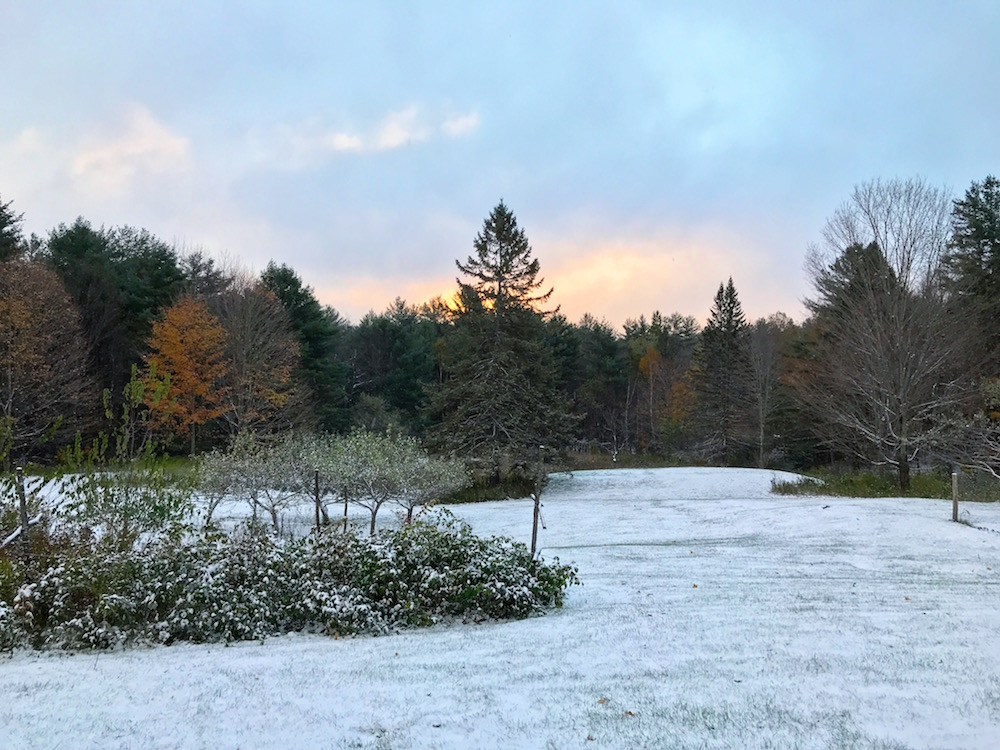
That premature snow turned our minds toward winter and our winter prep list became pressing. Each seasonal shift comes with a string of transitional tasks that need to be done before the homestead is ready to cope with the next band of weather. October is the month we waffle between hanging onto the withering fall and embracing the sedate cold of November.
If we make our winter transitions too soon, we’re liable to be in a house that’s too hot (if we’ve removed all the window screens) and driving a car with unnecessary snow tires (which reduce gas mileage). But if we wait too long, we find ourselves mincing through snow to load up the wood box and unable to drive one of our cars. So, we play this game of chicken every year and try to accurately time our glide into winter.
Here’s our complete winter prep list:
- Harvest and process any remaining vegetables from the garden
- Prep the garden for winter
- Do a final mow of the grass
- Do a final brushhogging of the fields
- Do a final clearing of the hiking trails to prepare them for snowshoeing. Remove downed trees.
- Take all the screens off of the house windows/doors and put on the exterior storm glass
- Remove all patio furniture, toys, baby pool, grill, etc from the back porch and set up the porch wood rack
- Stack wood in the porch wood rack
- Clean the woodstove combustor and clear old ashes from the stove to prepare for burning season
- Order propane and heating oil to be delivered
- Fell and winch enough trees to put up another few cords of firewood
- Remove the winch from the tractor and put the snow blower on
- Change and refresh all fluids on the tractor
- Rig up a lighting system on the tractor for wintertime snow blowing
- Put the snow tires on the cars
- Put away summer clothes and excavate winter gear from the basement for all four of us. Bribe Babywoods and Littlewoods to try on various pairs of boots, snowpants, coats, mittens, and hats until we find the combination of hand-me-downs that’ll fit for this winter.
- Decorate the house for Halloween and Thanksgiving!!!!
I guess there is a lot that we do before each season… I’ve never written it all out before because we perform these tasks over the course of September, October, and November; but October is the bubble of activity and the month that accelerates our progress. We seem to get that harbinger snow every October, which always propels us down this list. We’re not quite done with all these tasks yet–and some I wrote about last month–but I’ll detail a few highlights.
Wood On The Move
Mr. FW is forever doing something with wood. He’s either in the woods with a chainsaw felling trees or bucking logs or splitting logs or stacking wood or building something out of wood or putting wood into the woodstove to burn. The man loves wood and has a kinship with our forest. It’s one of the reasons we moved here and I’m always happy when I see him outside doing something with wood because I know he’s content and fulfilled on a deep level.
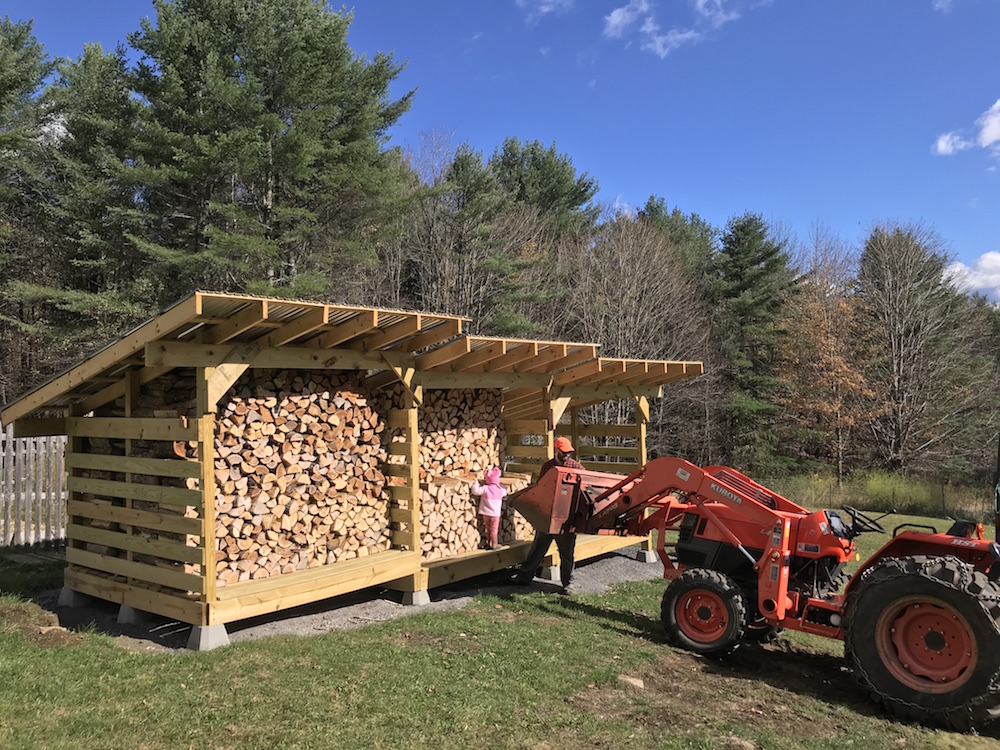
We recently had a conversation about this relationship with wood and agreed there’s a primal association of comfort with wood, and specifically with burning wood. Without sounding too ridiculous, we both feel a sense of calm and security when we see our stacked firewood and when we burn the wood in our stove to warm our home. Babywoods adores the woodstove and loves to camp out next to it, reading books and playing. She relocates toys in order to play as close to the emanating warmth as possible.
This evokes the Danish word hygge, which is somewhat untranslatable (Danish readers, please chime in!), but my understanding is that it essentially means a coziness that stems from being warm and snuggly indoors while it is cold outside. Hygge certainly gets at the essence of what we feel with our full woodshed and our burning woodstove, but I posit there’s also an elemental level of human security that derives from knowing you won’t freeze during the winter.
The Woodshed and the Porch Wood Rack
The woodshed Mr. FW built this summer is filling right up! Two of the three bays are now full (woot!!!), which equals six cords of wood (wondering what a cord is? check this out). The third bay is still empty, but Mr. FW is pretty sure he felled and skidded enough logs to fill it up before winter. He just needs some time to get out there and split and stack!
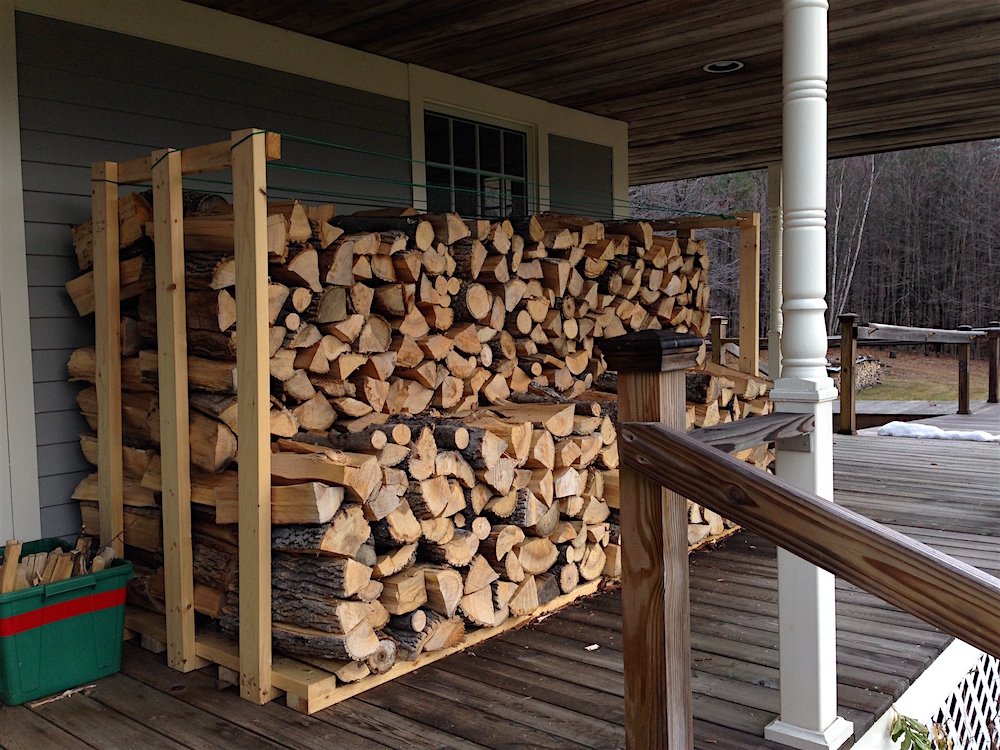
If you’re wondering what felling and skidding are, fear not, for I covered those terms in detail here.
In addition to the six cords out in the woodshed, we have another 1.5 cords in our woodrack (also built by Mr. FW) on our porch. This is our oldest, driest wood and it’s what we’ll burn first in our stove.
Conveniently, we have a set of French doors next to the woodstove that open onto the porch. A few years ago, Mr. FW affixed wheels to the bottom of our woodbox (which we found in our barn!) so that he can roll the woodbox onto the porch through the French doors, load it up with the wood from the porch wood rack, and then roll it back inside and park it next to the stove. Wood moving made easy! The wheels were an idea from one of our neighbors and we heartily followed his advice.
We burn approximately 3 cords of wood per winter (since we heat our home primarily via our woodstove) and so we’ll need to refill the porch wood rack once during the winter. For that maneuver, Mr. FW uses the tractor bucket to ferry wood from the woodshed onto the porch and then stacks it up on the porch rack. He’s considering building another porch wood rack to eliminate the need to make this mid-winter restocking trip, but he hasn’t had time yet. More to the point, we’re not exactly sure how much weight the porch can bear. Mr. FW wants to inspect the porch’s foundation before putting more than 1.5 cords of wood on it. So, TBD on that project.
First Fire Of The Season
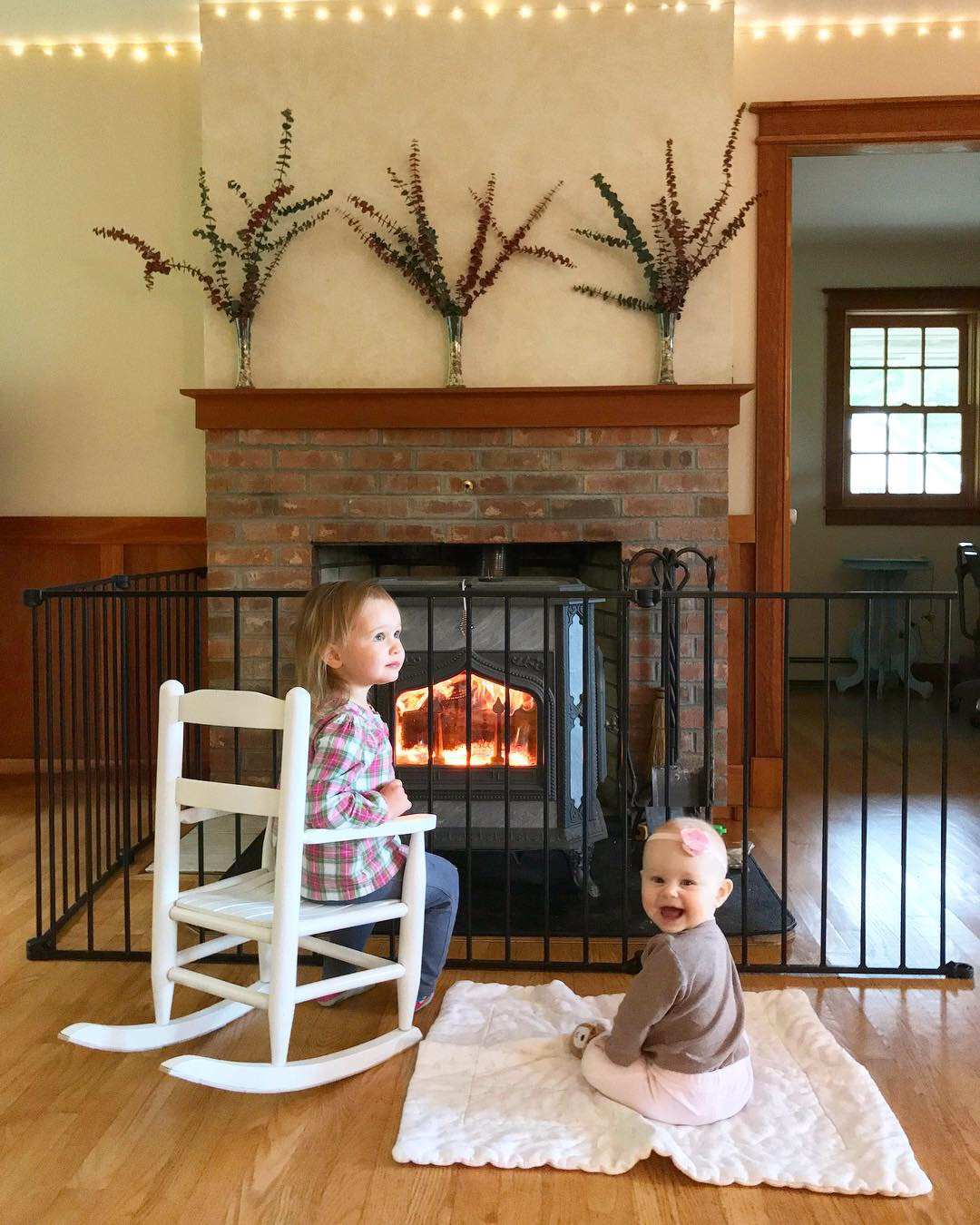
You won’t be surprised to hear that the first woodstove fire of the season is a cause for celebration. Appropriately, our first fire was on October 1st and we’ve been burning 1-2 fires per day fairly consistently since then. There’s been the odd warm day when we skip making a fire, but by the end of the month we were into regular burning.
We never want to start burning before we truly need to because we don’t want to run out of wood mid-winter (unlikely to happen now that we have a multi-year stash), but not a situation you want to find yourself in.
Mr. FW cleans our stove combustor every year, but he’s thinking we might need a new one in order to increase the stove’s efficiency. We are burning drier wood this year, which combustors like, but we’re thinking we might buy one just to have it on hand in the event of this combustor’s demise.
A combustor is similar to a catalytic converter in a car. It uses a screen made of rare metals to act as a catalyst for the smoke that passes through it. This causes the smoke to burn. Thus, instead of just burning wood, the combustor also burns the smoke, which makes our stove (we have the Fireview model from the Woodstock Soapstone Company) much more efficient than a stove without a combustor or other method of burning the smoke.
Tractor Maintenance
While the tractor gets used year-round, one of its primary utilities is as our winter snow blower. Mr. FW clears our quarter-mile (hilly) driveway himself, which means the tractor needs to be in peak condition. In preparation for this winter routine, Mr. FW changed the tractor’s oil, oil filter, fuel filter, air filter, and also greased it.
After discovering that clearing snow in the dark via headlamp is not ideal, Mr. FW designed and installed a lighting system on the tractor. He bought these LED lights, which he mounted on the front and back of the ROPS to enable him to see while clearing snow in early morning and evening. He also mounted a light switch on the dashboard and used a relay, appropriately fused. This should make in-the-dark snow clearing an easier and safer task.
Final Garden Harvest
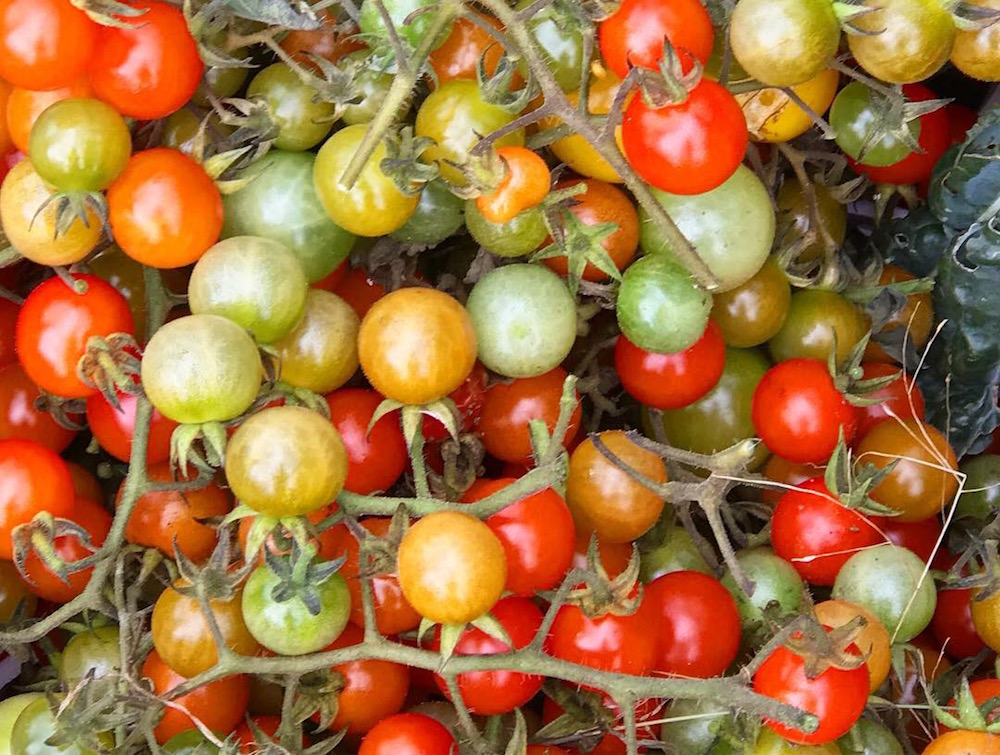
The day before our first hard frost was predicted, I jetted out to the vegetable garden to salvage any remaining plants. I brought in a MOUNTAIN of tomatoes–some ripe, some green–along with the final hot peppers. My plan was to do a final batch of sliced cherry tomatoes in the dehydrator–I love how those dehydrated tomatoes taste!–and lay the rest out to ripen indoors (thank you to Frugalwoods readers for introducing me to dehydrated tomatoes!!!!).
However. This did not happen. It’s with no small amount of embarrassment that I confess they all rotted due to negligence. I had at least a hundred tomatoes nestled in my “harvest wagon” (a kids’ wagon I got for $1 at a garage sale) in the corner of the kitchen. Every few days, I’d pass them on my way to a crying child or dinging washing machine or ringing phone and think, “oh! the tomatoes! I need to get on those!”
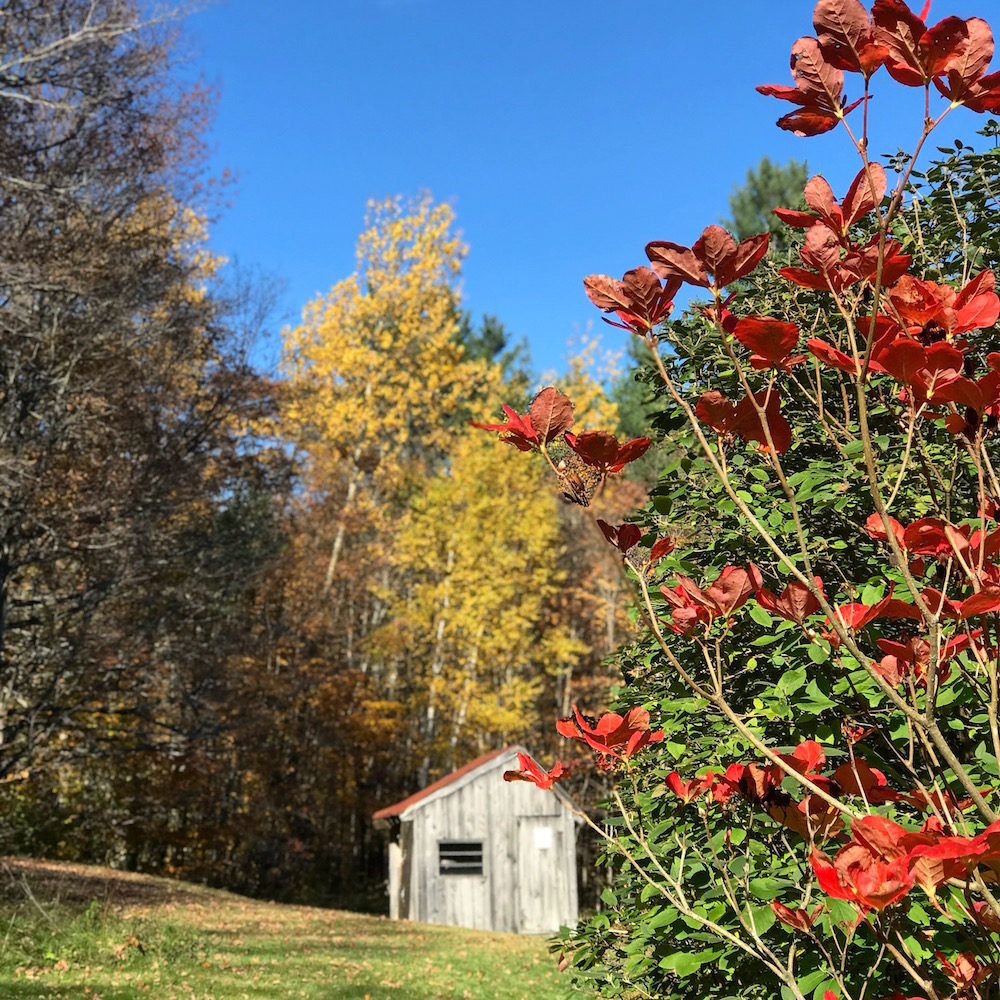
And then they’d be forgotten again. Relegated to their lowly spot on the floor, easily overlooked by we adults. When I finally summoned the time to kneel down next to this forlorn wagon, I knew the truth before lifting a single vine. Mold and rot crept up to claim each fruit. And so, Babywoods and I rolled the wagon out to the compost pile and dumped them in–every last tomato–destined to become part of next year’s garden. Whoops.
This is the sort of error that would’ve eaten me up during our first year on the homestead. I would’ve maligned all the time I spent harvesting the tomatoes and then been furious with myself for not processing them in time. But now? After almost three years on the homestead, and countless mistakes like this one, I can laugh at how much we try to do and fail to do. I have perspective on the prioritization that prevented me from getting to these tomatoes in time. As our responsibilities have expanded–through our two children and our acreage and our work–we’ve both become adept at the art of letting go. There’s no way we can complete all the ideas, tasks, and daily to-do’s–let alone our grander plans–so we’ve become comfortable accepting our limitations. I go to bed on time. I play with my kids. I hang out with my husband every night. Sometimes, some tomatoes rot. I can finally say that I’m okay with that.
Animal Shenanigans
We weren’t the only ones prepping for winter this month and, while every October we are witness to ridiculous animal antics, this year is–to date–taking the proverbial cake. In a big way.
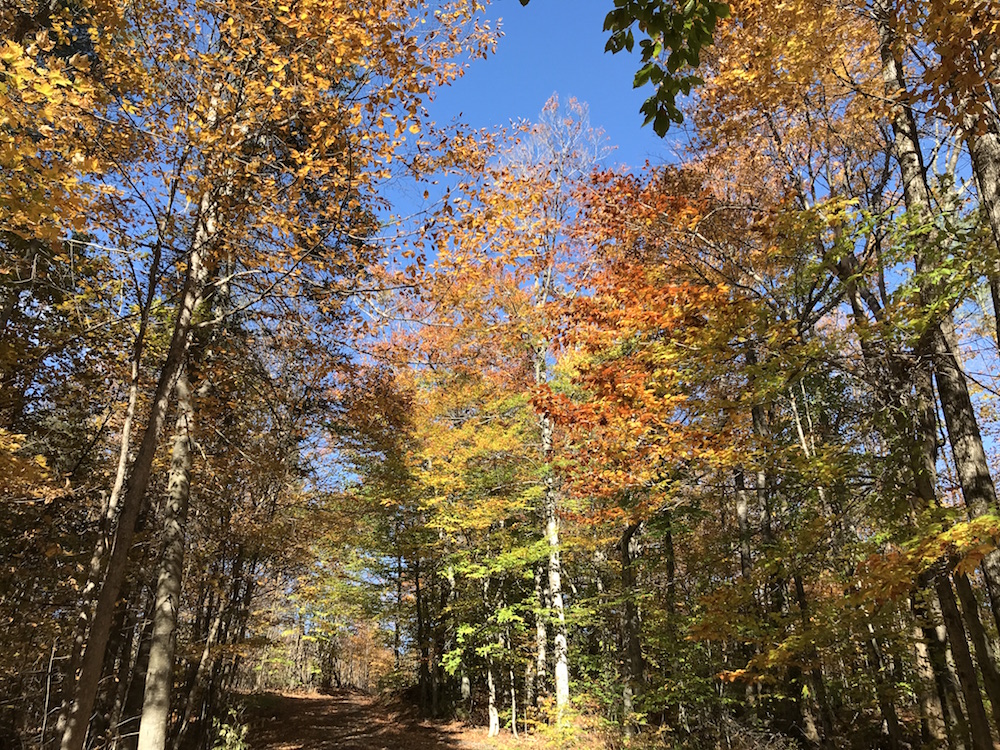
First, let me tell you about the bears. A little bear family–a mama and three cubs–found the old apple trees ringing our yard and decided to do some paws-on investigation. Thanks to our extensive rear-facing window situation, we watched their travails from inside. Mr. FW went out onto the balcony off our master bedroom (which I should note neither of us has even been on before–I have no idea what you’re supposed to do with it) and took a few excellent videos of the cubs taking turns scaling an apple tree and romping around in the woods. I posted the best video to Instagram and you can watch it right here.
Next up were the turkeys. This is not the first time I’ve written about the, ahem, intellectual challenges of these birds. I mean seriously, I can see why they’re the traditional Thanksgiving feast–you could catch one with your bare hands in our yard. And yes, they can fly, but they forget this fact in moments of distress and danger, which seems like an evolutionary missed opporunity if you ask me…
So you know the blueberry patch we now have? Mr. FW planted it this summer and it contains 28 blueberry bushes, three Saskatoon berry bushes, three honeyberry bushes, and three currant bushes, enclosed by a five foot high wire fence. A flock of turkeys flew in, which is fine, but after awhile we thought they might munch the plants, so Mr. FW went outside to flush them out of the enclosure. Now, being winged birds, you’d assume they’d just, ya know, fly on out, right? And to be fair to the species, some of them did just that.
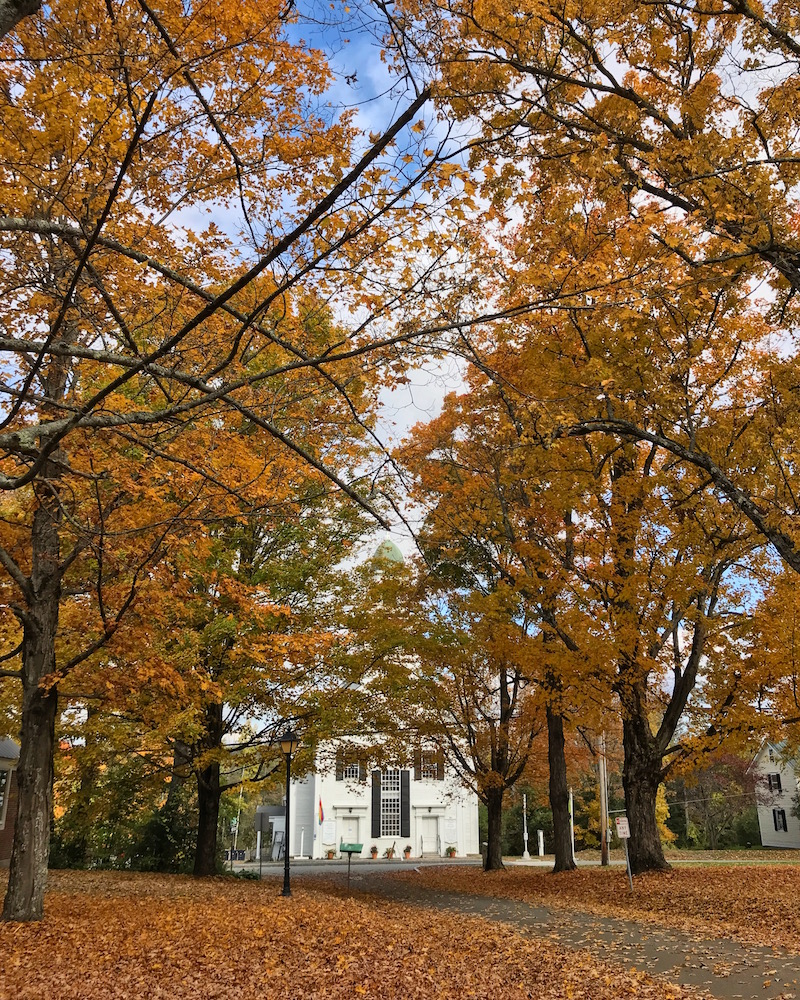
However. A contingent of the flock tried to RUN out of the enclosure. Repeatedly. I was certain we would have a turkey-stuck-in-the-fence situation on our hands. They kept ramming into the fence at full speed and looking bewildered that they’d once again rebounded back into the patch. Finally (this was after at least several minutes), they recalled their ability to fly and took flight (also an awkward proposal, but one that was effective).
My only life regret of late is that I didn’t get a video of this frenetic turkey activity. I also must share that the children’s book, Gobble Gobble Crash, is one of the more accurate renderings I’ve read of turkey’s propensity for flailing around like, well, bird-morons (that’s an affiliate link).
Finally, there was the deer. A lone deer managed to get trapped in the blueberry patch (I will note there wasn’t a single animal issue in this patch until this month) and made a much more graceful exit than the turkeys. In case anyone is wondering, a deer can easily leap over a five foot high fence without a running start. It was gorgeous to watch and also inspired a conversation about how we perhaps should’ve built a higher fence… interestingly, no creatures scaled the five foot fence (same type of fence, also built by Mr. FW) around our vegetable garden, which actually contained edibles. The blueberry patch, on the other hand, is nothing but berry-less baby berry plants.
Solar Check
Now that I’ve FINALLY (it only took me a year… ) written up the background information on our solar panels, I think I’ll try and include a solar update every month in this series. That’s probably the best way for me to actually remember to update you… So, in October, we only had six days of true solar production! Whoa. It was a rainy, cloudy month, which is why it’s key that we’re able to bank credits during the summer. We produced just 305 kWh in October.
Want More Fotos?!
While I only document homestead life once a month here on the blog, I post photos to Instagram (almost every day!) and updates to Facebook with much greater regularity! Join me there if you want more of our frugal woods. Some folks have asked about this and yes, I do try to post a picture to Instagram every day and have a pretty good track record, so if you’re craving more homestead pics, Instagram is your best bet.
And if you want to make sure you don’t miss a post here, sign-up for our handy dandy email list in the box below. You’ll get a message from me if you do…
Onward to November, frugal comrades!


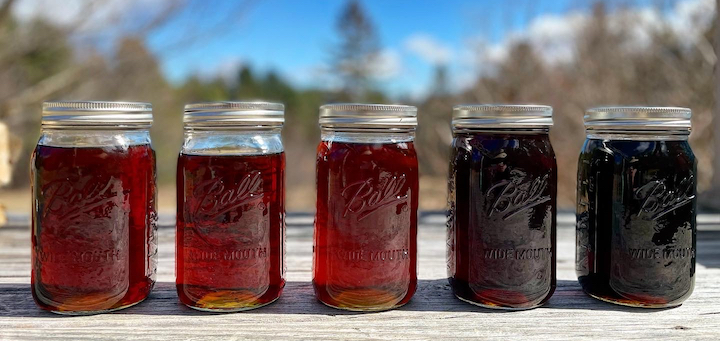
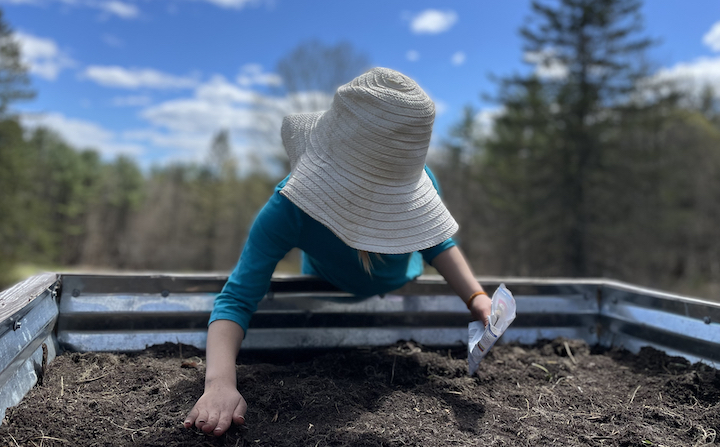
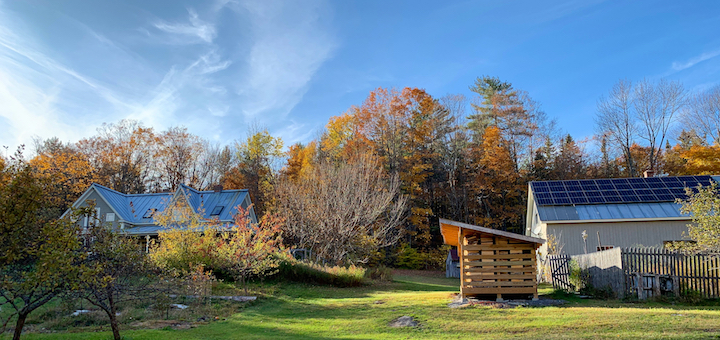
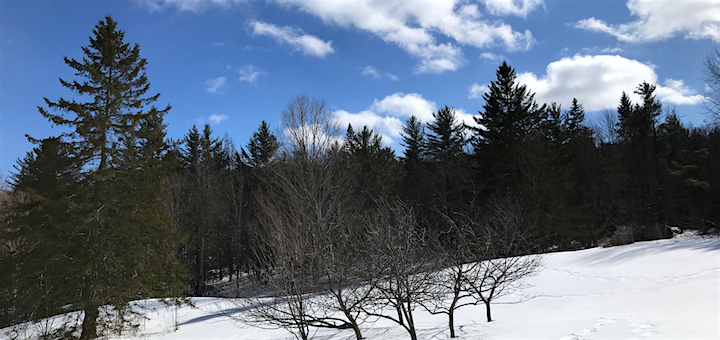
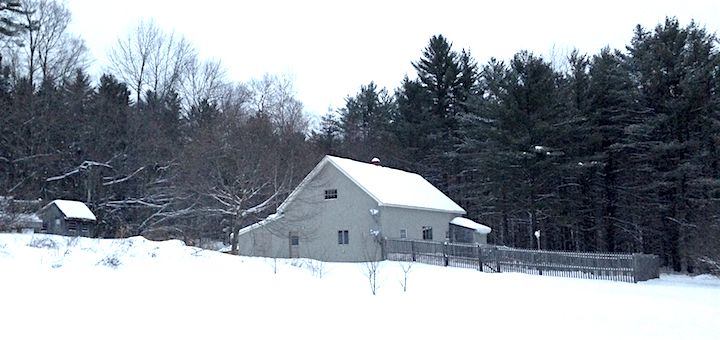
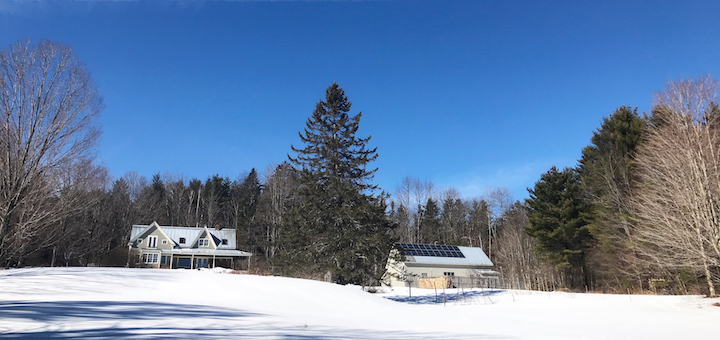
Such a fun read, I always love these updates stealing some of your ideas for our more modest 11 acres. 🙂
What is Mr Frugalwoods cooking for Thanksgiving?
Oooo, you are in luck! I’ll be writing about it on Monday 🙂
Oooh yay! This was the post I was thinking about also 😉 Can’t wait to read!
Your writing is so lovely and poetic! Thank you!
What adventures! And believe me, you are not the first person not to get to those tomatoes! Margaret Roach is a gardening idol of mine and she contends with deer and bear. She has a good approach to keeping deer away – a double fence not so high. Apparently the deer cannot judge the jumping distance between the two fence lines and so it works at keeping them out of the garden. Now I’m off to watch the bear cub video!
What a great fence idea–thank you for sharing!
Fabulous post and I am another reader of yours who is a Margaret Roach fan. As a semi-competent Master Gardener who is a huge fan of compost, you might want to rethink composting tomatoes and instead dump them in your woods. Tomatoes are prone to all sorts of fungal and other diseases and any waste material should not generally be added to compost that may end up in the area where you are going to plant tomatoes the next year. I think you are doing a fabulous job and I love the blog so please do not take this as a hateful comment – I would want someone to give me a heads up. I have personally killed thousands of plants and have learned some of the myriad ways to do so over the years!
Debbi–thank you so much for mentioning this, I actually had this exact thought AFTER I’d dumped them all in the compost! I wish I hadn’t and that, as you suggested, I’d dumped them in the woods instead. Definitely not my best idea ever ;). And please keep the advice coming–it is most appreciated by me!
The double fence is such a neat idea! We might experience with that in our garden. Thanks for sharing!
Loved reading this — my husband also spends many hours with wood by choice — and is a happier person for it. As a “volunteer Dane”, who lived in Denmark for a year and retains many close Danish friends, I can tell you that it is possible to “hygge” yourself in the summer, too, by doing ‘cozy’ things like playing board games with friends, singalongs, relaxing in front of a bonfire, toasting bread dough on sticks… but it certainly comes easiest in the winter, with candles and woodstoves and mulled wine!
Enjoy the snow today, a hygge-day if ever there was one…
Good to know! Thank you! And yes, today is a hygge one for sure 🙂
Thank you for such a great glimpse into your life, my wife and I are such big fans. We’d like to get a baby fence like you’re using around your fireplace, and use it to protect our Christmas tree from our one year old. Do you have any information about where you bought/sourced it, and what brand it is?
I wish I could be helpful! We got the gate for free off of our town listserve and it doesn’t have a brand marked on it anywhere. It is metal and quite large–I can tell you that. Good luck!
Hi Liz, I thought wood burning stoves put toxic emissions into the air, so the idea of heating the home with a wood burning stove was discouraged and possibly banned in some states. You are the expert, though, I’m just a suburban Atlanta lady, quite removed from that lifestyle. 🙂
That’s a great question! So it entirely depends on the type of woodstove you have. We have a newer, highly efficient woodstove that does not emit toxins. Per our woodstove company, “For the last 20 years, our wood stoves have met the clean air standard the EPA has proposed for 5 years from now (2020)!” The combustor in our stove burns not only the wood but also the smoke, so when it’s burning properly, there’s actually nothing coming out of the chimney. I wrote a bit more about our stove in this post: This Month On The Homestead: From Leaves to Snow.
Brenda, keep in mind that burning wood only burns what a tree emits if it were to die and decompose. So any of the carbon dioxide that comes out from a burning tree would go into the air if the same tree died and decomposed. It just goes into the air at a faster rate when burned as opposed to naturally decomposing. What is dangerous about woodstoves is the way in which those toxins naturally in wood can be turned into breathable particles, which are bad (inhaling smoke is bad in any form, whether it be cigarettes, incense, or a fireplace). So if you have a sealed fireplace, and it burns everything efficiently, then you are good in terms of the environment.
Also, note that trees must be felled if they are dying or diseased, so what the Frugalwoods often do is burn trees that needed to be cut down in the first place. Like the scary situation we are seeing in California, dying trees are rampant for fires that can go out of control, and if a forest isn’t managed properly, disaster can result.
I would also argue that there is a lot of externalities with other fuel sources that don’t get captured in the price. Many of the alternatives aren’t great either. Heating oil may be efficient but it’s tricky to get out of the ground, refine, AND you have the trouble and cost of transport. Natural gas has similar issues. Electric heat is relatively inefficient and you lose a lot in transmission.
There’s no perfect fuel source, unfortunately, but burning wood that grew within a mile of your house seems *relatively* benign when you have an efficient stove.
I didn’t know you had to do so much work to prepare for the winter on a homestead. For us, it means taking out winter clothes/shoes and turning on the heater @_@. Now I’m looking forward to your spring updates on the homestead with more harvesting, sunshine and fun!
I just wanted to comment to say thank you for using such a colorful vocabulary. Your blog is one of the few places in my daily life that I come across unfamiliar words. I had to look up the definition of “harbinger” and was pleasantly surprised by how appropriately it was used. I love words!
Thank you so much, Laura! I really appreciate that. I love words too–I used to read vocabulary books for fun as a kid (I was very popular, I assure you 😉 ) and so it’s a joy to finally put those words to use!!!!
Another word nerd here. I did not realize until well into adulthood that not everyone loves dictionaries or can get lost in them for an hour…I learned this after I gave my secretary a dictionary for Secretary’s Day, thinking she would love it. She did not and was very insulted.
That photo of the girls in front of the fire is priceless!!
Wow, you have your hands full for the winter! Seeing your posts are so refreshing due to the fact that I live in NYC and I would love to one day get land space like this (probably a little less lol) so I can have some more freedom. Thanks for the update!
That is a lot of firewood! Love your blog! You are so descriptive with your words that I almost feel like I’m there just reading about it. Hope you have a wonderful Thanksgiving 🙂
This is always a busy time for us as well. If even one aspect of your lifestyle is homestead based, there is this rush and push before the weather turns ugly. We prep our garden for winter, plant our garlic, move some of the kale plants to our yard garden, get the last of the wood stacked and covered, fill the oil furnace, clean the woodstove, prep the last of the vegies and fruit, butcher the chickens and pop in the freezer, deep clean my house since we will be indoors more frequently…And thru all of it is this sense of abundance. Even though it’s busy, it is also my favorite time of year.
I love your stories! They’re a world away from my childfree urban life in Philadelphia, but so enjoyable! While I’m sure there’s nothing actually simple about homesteading, your stories exude a charming simplicity all us city dwellers dream of (and you obviously did too!). Lovely pictures — I enjoy the images of scenes I don’t have here. I’m sorry for your tomato loss, though, as they’re one of my favorite foods. My Italian grandmother would’ve snatched those right up from you and made the most delicious homemade sauce to drown her homemade pasta. Oh well, you’ll have another batch next year. Stay warm!
A balcony off the master bedroom! A lovely place to sit and meditate, sip coffee early in the morning or tea at night. Sit quietly with the Mr.
Those bears are so, so beautiful! Oh man, I’ve made my fair share of mistakes growing produce as well. We had tomatoes up to our ears last year and we ate maybe, like, three of them? I’m trying to grow only foods that I KNOW we’ll eat. This year I’ve had bushels of okra on hand and zero people in the house that even enjoy eating okra. Oy.
October was a crazy time around here. I quit my job and started life as a self-employed writer. Things certainly calmed down at the end of October!
I miss Frugalhound! Every time you write about animals I wonder about her reactions to the wildlife. What a pup.
Whew, Mrs. FW. That to do list made me feel very anxious! I imagine it has become second nature to you now, but for those of us in the ‘burbs that feels a little overwhelming.
I do think there’s something about fire that’s so soothing. My husband installed an electric fireplace and built a mantle, and even though I know it’s not the real deal it makes our home so much cozier.
Hey guys, after reading your blog on preparing for Winter makes me very thankful that Carla and I live in a Motorhome. The foliage pictures were awesome. We just drove from Maggie Valley, hoping to see some, but no such luck. Stay warm!
The girls are growing and changing – so fast! Precious
With the two front doors, was your church originally a Shaker meeting house?
I have to admit, reading about snow in October… makes me very glad I live in SoCal. On the other hand, your turkey story is hilarious! I think checklists are a great idea, BTW. They help you plan the chores, but also the money you’ll need to expend on them.
Long Beach CA grandma here. Love, love, love your words and your style, Mrs. Frugalwoods.
Oh good I feel better now about doing the exact same thing with the last of our tomatoes. I picked them before a trip, hoping they would ripen while away…and… mold instead. They will feed the soil beautifully though.
I visited a homestead in Oregon once which had effectively built a cage around their bluberry bushes…. Higher fence with wire mesh over the top. Could be really handy for when your plants are producing, because it keeps the birds from getting to the berries before you do (and also keeps other critters out)!
The first section on this post was just lovely. Almost poetry.
Don’t feel bad about the tomatoes at all — they should produce a crop of plants without you doing a thing, come spring. They’ll love the compost pile.
Sometimes, some tomatoes rot. I can finally say that I’m okay with that… Congratulations and Wow! That may be a new mantra for me.
I imagine this is a deeply life changing lesson for you, and learned and a young age. To let go of what we just need to let go of may be one of the secrets to happiness. Thank you for another beautiful, funny, educational and deeply touching post.
Glad to hear Mr. Frugalwoods is checking the structural capacity of your porch. Hearing an unwelcome “creak” and feeling the floor below you shift is not welcome. In my book. you can’t beat the warmth of a wood stove as I sit in my chair next to our Vermont Castings stove. Thirty plus years old and still going strong. You must have Tom turkeys if you can get close – hens are far most skittish. I hope you and the girls are able to experience the sound of the Toms as they fan. A very cool sounding “whoosh”, especially when multiple Toms fan out. And keep an eye out in the summer for mama and babies. Observing wildlife is family event. I’d also recommend a pair (or two) of night vision binoculars/goggles.
You had far more patience with your garden than we did. Ours was put to bed by late September. But I’m already planning next years garden.
Reading about your winter preparation, it seems Mr FW thinks alot like my hubby. Mine put an LED bar on the ROPs bar on his tractor with a 12 bulb set facing forward and a smaller one facing the rear for visibility backing up. He uses the front bucket to clear snow, which can plow small amounts and scoop up the snow when we get hit with deeper accumulations. We have turkeys, bear, bobcat, coyotes, foxes, raccoons and weasels on our land. So we have our chickens and ducks inside enclosed runs with plastic fencing striping across the top to keep out hawks and eagles. Turkeys aren’t a threat to our birds, but would eat their feed. We have an electric fence around our garden and one around our bee hives to keep out bears, skunks and raccoons. One is solar powered as it is too far to to run electric from the house. We gathered leaves from the yard and field with a Billy Goat lawn vacuum with the shredder attachment as the shredded leaves with the manure from the chickens and ducks is excellent organic fertilizer he spread around the gooseberry, raspberry, currant and blueberry bushes as well as around the fruit trees and on the raised beds. Hubby shot a doe with his bow a couple weeks ago and I hope to get one with my rifle this season. Venison in the freezer as well as fruits and vegetables plus what I have canned from the garden we will be eating this winter. Yes life on the farm is a lot of work, but beats being a city dweller any day. It is so peaceful and relaxing seeing the fruits of the labors of our hands.
Keep an eye out for carpenter ants. When we had our wood stacked by our house, they invaded.
We used to live in the Colorado mountains and we regularly had black bears climbing a six foot fence to get to our hummingbird feeders. They were like bear juice boxes. Just fair warning if they discover your blueberries.
Laughed quite a bit at your turkey escapades!
—
http://www.areweadultsyet.com
Obviously you’re supposed to have sex on the master bedroom balcony.
I love the lights hanging below your ceiling (as seen from the fireplace picture you posted). Can you tell me what lights those are and how you got them to stay? We want to do something like that in our living room but before putting holes in the walls, we want to learn the best way to do this! Thanks.
Seeing the cords of firewood and the shed reminded me of a great book that would make a great gift for Mr. Frugalwoods. It is Norwegian Wood: Chopping, Stacking, and Drying Wood the Scandinavian Way. It’s a couple of years old so you might find a good used copy somewhere. https://smile.amazon.com/Norwegian-Wood-Chopping-Stacking-Scandinavian/dp/1419717987/ref=sr_1_1?s=books&ie=UTF8&qid=1544728674&sr=1-1&keywords=firewood+book It goes into great detail on which trees make the best fires due to their energy density and other factors I had never considered for my fires. Happy Holidays!
This book is actually on Mr. FW’s wishlist! He’s been wanting to read it for several years now
I liked your thoughts about firewood, and it reminded me of one of my favourite reads ever. A small book of essays by an architect: “Thermal Delight in Architecture” by Lisa Heschong. I think it was published by MIT Press. Very interesting thoughts about different materials, building types, traditional ways of heating and cooling, and the pleasure we derive from them. Also related to frugality since traditional ways of heating+cooling are most often free or use little resources. Do you still have access to a good library? Maybe you can order and enjoy the read 🙂
Please comment on how you use your dried cherry tomatoes?
I put them in salads! They’re also delicious on their own and my toddler loves eating them for snacks.
Hi Mrs. FW, long time reader here who recently just just bought a similar tractor. I am looking to install lights on it and I remembered that you had put together a blurb about LED lights. I found it but the lights in your link are no longer listed. Could you refresh the link for me please?
Thanks for all the great content!